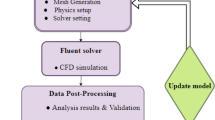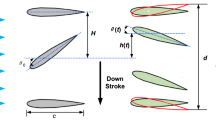Abstract
This study mainly focused on the comparison of the effect of single and simultaneous suction and blowing jets on the aerodynamic performance of an airfoil with/without flap to evaluate the most effective flow control configuration using computational fluid dynamics (CFD) method. Moreover, the effect of applying single and simultaneous jets have been conducted on delaying and controlling the flow separation. The results were obtained using two-dimensional incompressible Unsteady Reynolds-Averaged Navier–Stokes (URANS), and the turbulence was simulated with SST k-ω turbulence model. Also, different parameters including two jet locations (Ljet), three jet velocity ratios (Rjet), three jet angles (θjet) and three flap deflections (δf) were analyzed to find the most effective case of applying flow control jets to delay the boundary layer separation. It was concluded that applying a single suction jet and simultaneous suction and blowing jets on the flapped airfoil was more effective to improve the lift-to-drag ratio (CL/CD) than applying these jets to the without flap case. The maximum value of CL/CD was achieved by single suction jet for the without flap case which was equal to 73.7. The maximum increment of stall angle over the without flap airfoil and flapped airfoil was obtained by applying single suction jet, which increased the stall angle from 14° to 20° and 14° to 16° for the suction angle of −90° and suction velocity ratio of 0.15, respectively.

























Similar content being viewed by others
Abbreviations
- α:
-
Angle of attack
- β:
-
The angle between the freestream velocity direction and the local jet surface
- c:
-
Airfoil chord length
- CP :
-
Pressure coefficient
- CL :
-
Lift coefficient
- CD :
-
Drag coefficient
- ε:
-
Turbulent dissipation rate
- k:
-
Turbulent kinetic energy
- μ:
-
Viscosity
- μt :
-
Turbulent viscosity
- ρ:
-
Density
- τ:
-
Shear stress
- δf :
-
Flap deflection
- P:
-
Pressure
- Re:
-
Reynolds number
- U∞ :
-
Free stream velocity
- Y+ :
-
Dimensionless wall distance
- \( \delta_{ij} \) :
-
Kronecker Delta
- θjet :
-
Jet angle
- Ljet :
-
Jet location
- Ujet :
-
Jet velocity
- Rjet :
-
Jet velocity ratio
References
Kim J, Hahn S, Kim J, Lee D K, Choi J, Jeon W P and Choi H 2004 Active control of turbulent flow over a model vehicle for drag reduction. J. Turbul. 5: 1–12
You D and Moin P 2008 Active control of flow separation over an airfoil using synthetic jets. J. Fluid Struct. 24: 1349–1357
Lin J C, Howard F G and Selby G V 1990 Small submerged vortex generators for turbulent flow separation control. J. Spacecraft Rockets 27: 503–507
Zhou Y, Hou L and Huang D 2017 The effects of Mach number on the flow separation control of airfoil with a small plate near the leading edge. Comput. Fluids 156: 274–282
Yousefi K, Saleh S R and Zahedi P 2013 Numerical investigation of suction and length of suction jet on aerodynamic characteristics of the NACA 0012 airfoil. Int. J. Mater. Mech. Manuf. 1: 136–142
Fatahian E, Nichkoohi A L and Fatahian H 2019 Numerical study of the effect of suction at a compressible and high Reynolds number flow to control the flow separation over Naca 2415 airfoil. Prog. Comput. Fluid Dyn. 19: 170–179
Huang L, Huang P G, LeBeau R P and Hauser T 2004 Numerical study of blowing and suction control mechanism on NACA0012 airfoil. J. Aircraft 41: 1005–1013
Fatahian H, Salarian H, Nimvari M E and Fatahian E 2018 Numerical study of suction and blowing approaches to control flow over a compressor cascade in turbulent flow regime. Int. J. Automot. Mech. Eng. 15: 1–18
Cattafesta III L N and Sheplak M 2011 Actuators for active flow control. Annu. Rev. Fluid Mech. 43: 247–272
Huang L, Huang G, LeBeau R and Hauser T 2004 Optimization of blowing and suction control on NACA0012 airfoil using genetic algorithm. In: 42nd AIAA Aerospace Sciences Meeting and Exhibit, pp. 225–234
Huang L, Huang G, LeBeau R P and Hauser T 2007 Optimization of airfoil flow control using a genetic algorithm with diversity control. J. Aircraft 44: 1337–1349
LeBeau R, Beliganur N, Hauser T and Schauerhamer D 2007 Applying genetic algorithms to complex computational fluid dynamics simulations. In: 45th AIAA Aerospace Sciences Meeting and Exhibit, pp. 766–775
Shehata H, Zakaria M, Hussein A and Hajj M R 2018 Aerodynamic analysis of flapped airfoil at high angles of attack. In: 2018 AIAA Aerospace Sciences Meeting, pp. 37–749
Mohammadi M and Taleghani A S 2014 Active flow control by dielectric barrier discharge to increase stall angle of a NACA0012 airfoil. Arab. J. Sci. Eng. 39: 2363–2370
Arunraj R, Logesh K, Balaji V, Ravichandran T and Yuvashree G K 2019 Experimental investigation of lift enhancement by suction-assisted delayed separation of the boundary layer on NACA 0012 airfoil. Int. J. Ambient Energy 40: 243-247
Seifert A, Bachar T, Koss D, Shepshelovich M and Wygnanskil I 1993 Oscillatory blowing: a tool to delay boundary-layer separation. AIAA J. 31: 2052–2060
Seifert A, Darabi A and Wyganski I 1996 Delay of airfoil stall by periodic excitation. J. Aircraft 33: 691–698
Seifert A and Pack L 1999 Oscillatory excitation of unsteady compressible flows over airfoils at flight Reynolds numbers. In: 37th Aerospace Sciences Meeting and Exhibit, pp. 925–936
Greenblatt D and Wygnanski I J 2000 The control of flow separation by periodic excitation. Prog. Aerosp. Sci. 36: 487–545
James S E, Suryan A, Sebastian J J, Mohan A and Kim H D 2018 Comparative study of boundary layer control around an ordinary airfoil and a high lift airfoil with secondary blowing. Comput. Fluids. 164: 50–63
Critzos C C, Heyson H H and Boswinkle Jr R W 1955 Aerodynamic characteristics of NACA 0012 airfoil section at angles of attack from 0 deg to 180 deg. No. NACA-TN-3361. National Aeronautics and Space Administration, Washington DC
Genç M S, Kaynak Ü and Yapici H 2011 Performance of transition model for predicting low Re aerofoil flows without/with single and simultaneous blowing and suction. Eur. J. Mech. B-Fluid 30: 218–235
Yousefi K, Saleh R and Zahedi P 2014 Numerical study of blowing and suction slot geometry optimization on NACA 0012 airfoil. J. Mech. Sci. Technol. 28: 1297–1310
Boualem K, Yahiaoui T and Azzi A 2017 Numerical investigation of improved aerodynamic performance of a NACA 0015 airfoil using synthetic jet. Int. J. Mech. Aerosp. Ind. Mechatron. Manuf. Eng. 11: 487–491
Lei J, Liu Q and Li T 2019 Suction control of laminar separation bubble over an airfoil at low Reynolds number. Proc. Inst. Mech. Eng. G-J Aerosp. 233: 81-90
Tadjfar M and Asgari E 2018 Active flow control of dynamic stall by means of continuous jet flow at Reynolds number of 1× 106. J. Fluid Eng. 140: 1–22
Obeid S, Jha R and Ahmadi G 2017 RANS simulations of aerodynamic performance of NACA 0015 flapped airfoil. Fluids 2: 1–15
Hassan A 1999 Predicted aerodynamic characteristics of a NACA 0015 airfoil having a 25% integral-type trailing edge flap. NACA CR/-1999–209328; NASA Technical Reports Server (NTRS): Hampton, VA, USA, pp. 209–328
Zhang W, Zhang Z, Chen Z and Tang Q 2017 Main characteristics of suction control of flow separation of an airfoil at low Reynolds numbers. Eur. J. Mech. B Fluid 65: 88–97
Ma D, Li G, Yang M and Wang S 2018 Research of the suction flow control on wings at low Reynolds numbers. Proc. Inst. Mech. Eng. G-J Aerosp. 232: 1515-1528
Ockfen A E and Matveev K I 2009 Aerodynamic characteristics of NACA 4412 airfoil sction with flap. Int. J. Nav. Arch. Ocean 1: 1–12
Menter F R 1994 Two-equation eddy-viscosity turbulence models for engineering applications. AIAA J. 32: 1598–1605
Catalano P and Amato M 2003 An evaluation of RANS turbulence modelling for aerodynamic applications. Aerosp. Sci. Technol. 7: 493–509
Menter F R, Kuntz M and Langtry R 2003 Ten years of industrial experience with the SST turbulence model. Turbul. Heat Mass Transf. 4: 625–632
Cao S, Li Y, Zhang J and Deguchi Y 2019 Lagrangian analysis of mass transport and its influence on the lift enhancement in a flow over the airfoil with a synthetic jet. Aerosp. Sci. Technol. 86: 11–20
Hao W, Ding Q and Li C 2019 Optimal performance of adaptive flap on flow separation control. Comput. Fluids, 179: 437–448
Liang C and Li H 2018 Effects of optimized airfoil on vertical axis wind turbine aerodynamic performance. J. Braz. Soc. Mech. Sci. 40: 88–100
Liu D and Nishino T 2019 Unsteady RANS simulations of strong and weak 3D stall cells on a 2D pitching aerofoil. Fluids 4: 40–52
Wu Z, Cao Y, Nie S and Yang Y 2017 Effects of rain on vertical axis wind turbine performance. J. Wind Eng. Ind. Aerodyn. 170: 128–140
Wu Z and Cao Y 2015 Numerical simulation of flow over an airfoil in heavy rain via a two-way coupled Eulerian–Lagrangian approach. Int. J. Multiphas. Flow 69: 81–92
Versteeg H K and Malalasekera W 2007 An introduction to computational fluid dynamics: the finite volume method, 2nd edn. Pearson education, UK, pp. 273–279
Ge M, Zhang H, Wu Y and Li Y 2019 Effects of leading edge defects on aerodynamic performance of the S809 airfoil. Energy Convers. Manag. 195: 466–479
Monir H E, Tadjfar M and Bakhtian A 2014 Tangential synthetic jets for separation control. J. Fluid Struct. 45: 50–65
Resendiz Rosas C 2005 Numerical simulation of flow separation control by oscillatory fluid injection. Doctoral dissertation, Texas A & M University
Yousefi K and Saleh R 2014 The effects of trailing edge blowing on aerodynamic characteristics of the NACA 0012 airfoil and optimization of the blowing slot geometry. J. Theor. Appl. Mech. 52: 165–179
Dannenberg R E and Weiberg J A 1952 Section characteristics of a 10.5-percent-thick airfoil with area suction as affected by chordwise distribution of permeability. NASA TN 2847
Jacobs E N and Sherman A 1937 Airfoil section characteristics as affected by variations of the Reynolds number. NACA Report, No. 586-231
Farhadi A, Rad E G and Emdad H 2017 Aerodynamic multi-parameter optimization of NACA0012 airfoil using suction/blowing jet technique. Arab. J. Sci. Eng. 42: 1727–1735
Gregory N and O’reilly C L 1973 Low-speed aerodynamic characteristics of NACA 0012 aerofoil section, including the effects of upper-surface roughness simulating hoar frost. London: HM Stationery Office
Schlichting H and Gersten K 2000 Boundary-layer control (suction/blowing). In: Boundary-Layer Theory. Berlin, Heidelberg: Springer, pp. 291–320
Mazaheri K, Nejati A and Kiani K C 2017 The application of suction and blowing in performance improvement of transonic airfoils with shock control bump. Sci. IRAN Trans. B 24: 274–283
Chen C, Seele R and Wygnanski I 2012 Separation and circulation control on an elliptical airfoil by steady blowing. AIAA J. 50: 2235–2247
Chen C, Seele R and Wygnanski I 2013 Flow control on a thick airfoil using suction compared to blowing. AIAA J. 51: 1462–1472
Williamson G 2012 Experimental wind tunnel study of airfoils with large flap deflections at low Reynolds numbers. Master’s Thesis, Aerospace Engineering, The University of Illinois at Urbana-Champaign, Champaign, IL, USA, pp. 14–60
Author information
Authors and Affiliations
Corresponding author
Rights and permissions
About this article
Cite this article
Fatahian, E., Lohrasbi Nichkoohi, A., Salarian, H. et al. Comparative study of flow separation control using suction and blowing over an airfoil with/without flap. Sādhanā 44, 220 (2019). https://doi.org/10.1007/s12046-019-1205-y
Received:
Revised:
Accepted:
Published:
DOI: https://doi.org/10.1007/s12046-019-1205-y




